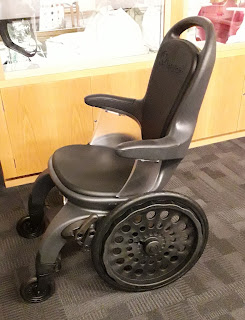If you’re a
regular reader of the museum’s blog, you’ll know that we like to promote plastics’
virtues because this material group is often misunderstood and misrepresented.
Reading Pam’s recent post where she talked about the EasyRoller 2 wheelchair, she highlighted ten different types of
plastics that were used within the chair’s construction, each carefully chosen
to match the intended application. It made me think about the fact that this is
not always the case: sometimes designers and manufacturers get it wrong.
 |
Left to right: the collapsible washing basket, the
silicone beginning to fail and the replacement. Image credit: Katherine Pell |
Continuing with the washing theme, a few years ago I also bought some plastic pegs because I felt the wooden ones we had been using left too much of a noticeable mark on the clothes. I acquired two different types: some white polypropylene ones that replicated the design of the more traditional wooden style and some polystyrene ergonomic pegs in red, purple and grey. They both promised to grip the clothes in a more delicate way and have indeed been successful in solving this particular issue. However, I am now finding that all of the ergonomic pegs are becoming embrittled, with the finger grips starting to snap off. In the summer they might be out on the line all day and, unfortunately, they are obviously not sufficiently UV resistant to deal with this amount of sun exposure resulting in breakage at the weak point in the design. Their limited lifespan simply cannot compete with the wooden ones I have owned for over twenty years, although the white ones are faring better. The broken pegs are now being repurposed to secure netting around plants in the garden where they do not have to be opened/closed on a regular basis.
 |
Left to right: the three different types of
pegs, the snapped finger grips and a broken peg being repurposed. Image credit: Katherine Pell |
At Christmas, my daughter was given a travel mug made from eco-friendly bamboo with a heat-resistant silicone lid and grip. In manufacture, the bamboo has likely been ground into a powder and combined with a synthetic resin such as melamine, a material renowned for being easily stained by organic acids such as the tannin found in tea. I think the mug was only used twice before we started to notice the interior surface becoming discoloured so, once again, perhaps not the best choice of material for this particular purpose? We have also found a new use for the cup, this time as a toothbrush holder in the bathroom.
 |
Left to right: the travel mug, the stained
interior and a new use. Image credit: Katherine Pell |
So, does any of this really matter? I appreciate everything has a finite lifespan and I probably expect too much of these everyday products but bad design, which includes material selection, contributes to negative perceptions about plastics when the product ultimately fails. Even if the purchase cost is not very high (such as in the case of the clothes pegs), I still don’t want disposability. I continue to believe that the plastics material family is amazing but it has to be the right material for the job. Luckily, we have some great examples in the collection to successfully demonstrate this such as an artificial eye, flame resistant racing gloves and a wind-up radio amongst many, many other objects. We also have resources that explain what is good as well as what is bad about plastics if you want to find out more.
 |
Left to right: AIBDC
: 008357, AIBDC
: 005887 and AIBDC
: 000415. |
Katherine Pell
Collections Officer















